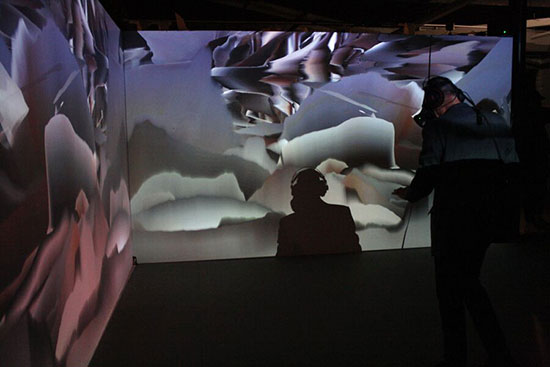One minute you’re in at the 9e2 festival in Seattle; the next you’re in a strange landscape that rises up before you. Pink hills erupt at your feet and then shoot up toward the sky. Geometrical patterns are alive, pulsating in response to dense electronic sounds, while giant, whirling patterns of light shoot right through you.
You’re able to look around, walk around, and be immersed in this alien dimension—at least until you remember that you’re holding a cord. As if in a lucid dream, you grasp the cord as your connection back to waking life, as you take off your goggles and headphones and hand them over to the next person.
The landscape was part of The Observer Effect, a virtual reality installation for the 9e2 festival, celebrating nine evenings of art, science and technology in Seattle from October 21 to 29, 2016.
.

"The Observer Effect" at the 9e2 festival. Photo by Amber Cortes.
.
“It’s like a virtual cave painting,” explained Reilly Donovan, part of the team of three artists and programmers who created The Observer Effect. Interviewed at King Street Station on October 24, 2016, he said the piece references both Plato’s “The Simile of the Cave” and CAVE, the proper name of the cube-like space and three-projector system that enables the virtual reality experience. CAVE is a recursive acronym for Cave Automatic Virtual Environment.
Virtual Reality (VR), already a hot market item in gaming technology and a rising tool for filmmakers and journalists, is promising to be a revolutionary medium in the world of art as well. Already it has started showing up at art fairs and in galleries, and at museums such as MoMA and The New Museum in New York. Visual artists like Jon Rafman of Canada and Rachel Rossin have begun to play with the potential of VR in their work. For artists, who are often the first to embrace new technologies in their pursuit of innovation, VR still feels very novel.
“It’s somewhat of a new language for us,” admitted David Stout, visual artist, composer, and one half of Noise Fold, an installation and performance duo who worked with Donovan to create The Observer Effect. As their website explains, Stout and Corey Metcalf, the other half of Noise Fold, are “working at the fuzzy boundary-blurring nexus of visual art, music and interactive cinema.”
Stout is fascinated by the way VR affects the physical reactions of participants immersed in the experience of the piece.
“Sometimes dancers will come in and you instantly know they're a dancer, because they start dancing with the image,” Stout said in an interview at King Street on October 22, 2016. “Some people lay down on the floor and look up into the ceiling. Other people want to interact with the forms. Some people are sort of afraid, and you can see that it affects their physical equilibrium; they want to walk very slowly, they get dizzy.”
Part of the idea behind The Observer Effect is that it’s generative—and thus unpredictable—so no viewer will ever see the same exact landscape, or hear the same array of sounds.
.

"The Observer Effect" at the 9e2 festival. Photo by Amber Cortes.
.
“All of the sound in it is generated by analyzing the shapes that are in the space,” explained Metcalf, an interactive media and sound artist. “And so it's looking at the geometry, and the texture data, to create the sound. And we're doing a lot with using algorithmic noise movies to create extrusions of the geometry.”
Metcalf has a film and theater background, but was drawn to programming as a way to “do things that the tools I was using couldn't do.” Instead of the regular two-dimensional moving image on a screen, he wanted to use virtual reality to make “real time, generative video work” that could create a completely immersive piece of art.
“VR is so much more than a detached experience,” Metcalf said, “like when watching image based media. Virtual Reality gives the visual image the same impact that an immersive sonic experience does. And that creates a whole other field of explorations of possibility.”
.

"The Observer Effect" at the 9e2 festival. Photo by Amber Cortes.
.
________________________________
BASIC FACTS: The Virtual Reality installation The Observer Effect was presented as part of the 9e2 Festival in Seattle, Washington held from October 21 to 29, 2016. www.9e2seattle.org
________________________________
Copyright 2016 Hamptons Art Hub LLC. All rights reserved.
